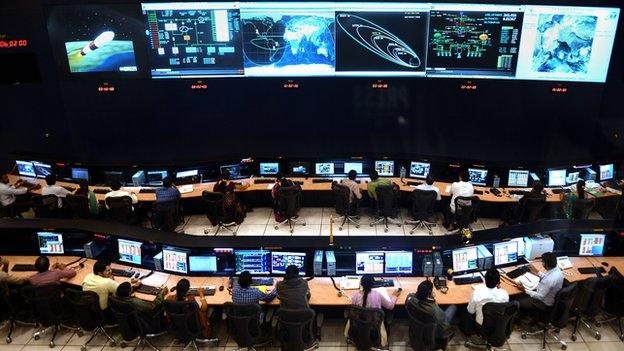Indian media: 'Namaste, Mangalyaan'
- Published

The probe went into orbit "after a few nail-biting moments"
Media in India are over the moon about the country's successful mission to Mars.
All of them highlight the fact that it has become the first country to successfully send a spacecraft into orbit around the Red Planet on its maiden attempt.
Mangalyaan, the Indian Space Research Organisation's (ISRO) probe, started circling Mars "after a few nail-biting moments", says Hindustan Times, external.
The paper recalls that "more than half the world's previous attempts - 23 out of 41 Mars missions - have failed, including attempts by Japan in 1999 and China in 2011".
Deccan Chronicle, external pays tribute to the space scientists and engineers behind Mangalyaan. "Team Isro has designed, assembled, tested and launched the Mars Orbiter Mission (MOM) in just 15 months," says the daily.
"For all the action at the ground station, there was not much the scientists had to do. More than 10 days ago, they had uplinked all the commands for the manoeuvres to the spacecraft. MOM, like an obedient child, carried them out perfectly," reports The Times of India, external.
The Indian Express, external writes that ISRO has launched a Twitter account and a Facebook page for its orbiter to make sure that everyone outside the control room is updated on the success of the probe. When Mangalyaan entered Martian orbit, the Facebook page already had 436,792 likes and the Twitter account 17,945 followers.
The First Post, external website reports that Nasa's Curiosity Rover has greeted MOM from the surface of the Red Planet.
"Namaste, @MarsOrbiter! Congratulations to @ISRO and India's first interplanetary mission upon achieving Mars orbit."
"India's Mars Orbiter has made it to the top, but is it a one-hit wonder?" asks The Hindu, external.
The daily comments that the achievement "has important consequences for scientific and political reasons", but warns that "we must be careful not to overstate this capability".
"Even if India has launched a spacecraft to Mars, the payload limit and the lack of an inclusive scientific agenda still stand in the way of taking full advantage of scientific interest and infrastructure on the ground," it explains.
"Sexualisation" of women
In other news, a new UN-sponsored study says sexualisation of women features heavily in Indian movies with less representation of strong roles, reports The Economic Times, external.
The study, conducted by the Geena Davis Institute on Gender in Media, and supported by UN Women and The Rockefeller Foundation, has looked at female characters in popular cinema from around the world.
India has the maximum portrayals of attractive women in its films and at least 35% of female characters are shown with some degree of nudity, it says.
The study adds that Indian movies very rarely show women in "significant speaking roles", or "working as engineers and scientists".
And finally, the Indian cabinet is set to approve a large-scale programme to promote cleanliness in the country, the Hindustan Times, external reports.
The scheme, to be launched in October, aims to provide a toilet in every household in the country and make a "Clean India" by 2019, it adds.
As part of the initiative, the government will build toilets in 10.4 million homes and 500,000 public toilets in urban areas, as well as 88 million toilets in rural areas.
The initiative is significant as a large number of Indians still do not have easy access to proper sanitation, the paper explains.
According to the 2011 census data, 12% out of the 67 million households in urban India defecate in the open, says Hindustan Times.
BBC Monitoring reports and analyses news from TV, radio, web and print media around the world. For more reports from BBC Monitoring, click here. You can follow BBC Monitoring on Twitter, external and Facebook, external.